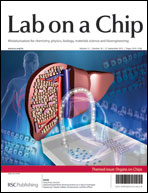Current in vitro and animal tests for drug development are failing to emulate the systemic organ complexity of the human body and, therefore, to accurately predict drug toxicity. In this study, we present a multi-organ-chip capable of maintaining 3D tissues derived from cell lines, primary cells and biopsies of various human organs. We designed a multi-organ-chip with co-cultures of human artificial liver microtissues and skin biopsies, each a 1/100 000 of the biomass of their original human organ counterparts, and have successfully proven its long-term performance. The system supports two different culture modes: i) tissue exposed to the fluid flow, or ii) tissue shielded from the underlying fluid flow by standard Transwell® cultures. Crosstalk between the two tissues was observed in 14-day co-cultures exposed to fluid flow. Applying the same culture mode, liver microtissues showed sensitivity at different molecular levels to the toxic substance troglitazone during a 6-day exposure. Finally, an astonishingly stable long-term performance of the Transwell®-based co-cultures could be observed over a 28-day period. This mode facilitates exposure of skin at the air–liquid interface. Thus, we provide here a potential new tool for systemic substance testing.

You have access to this article
 Please wait while we load your content...
Something went wrong. Try again?
Please wait while we load your content...
Something went wrong. Try again?


 Please wait while we load your content...
Please wait while we load your content...